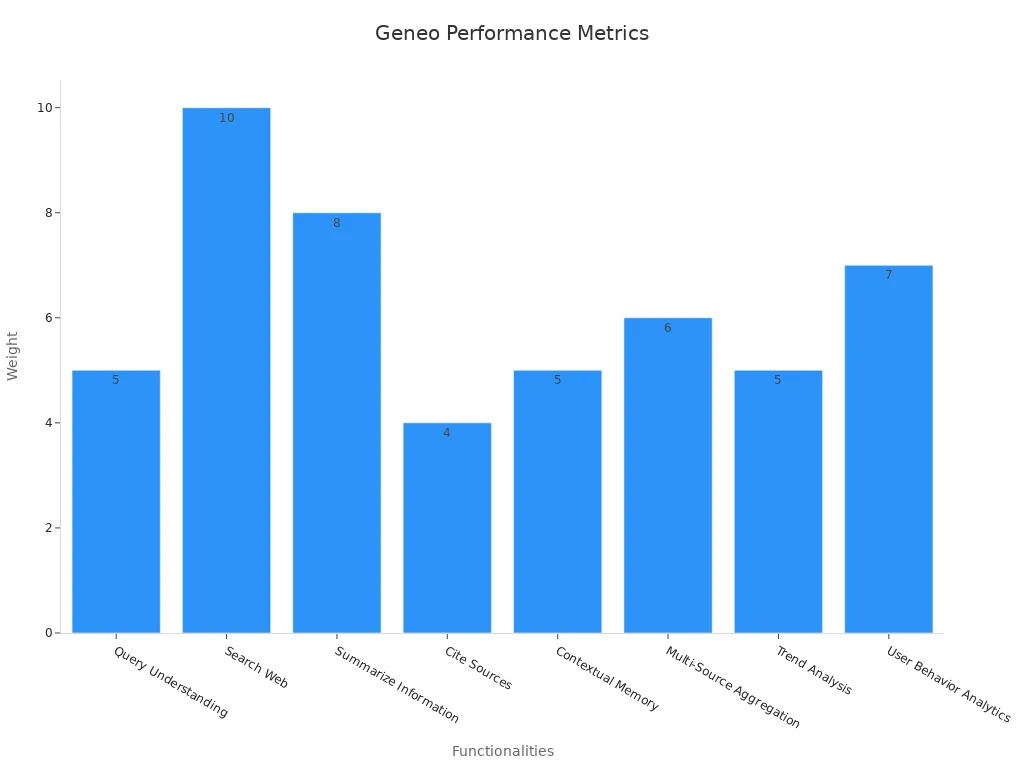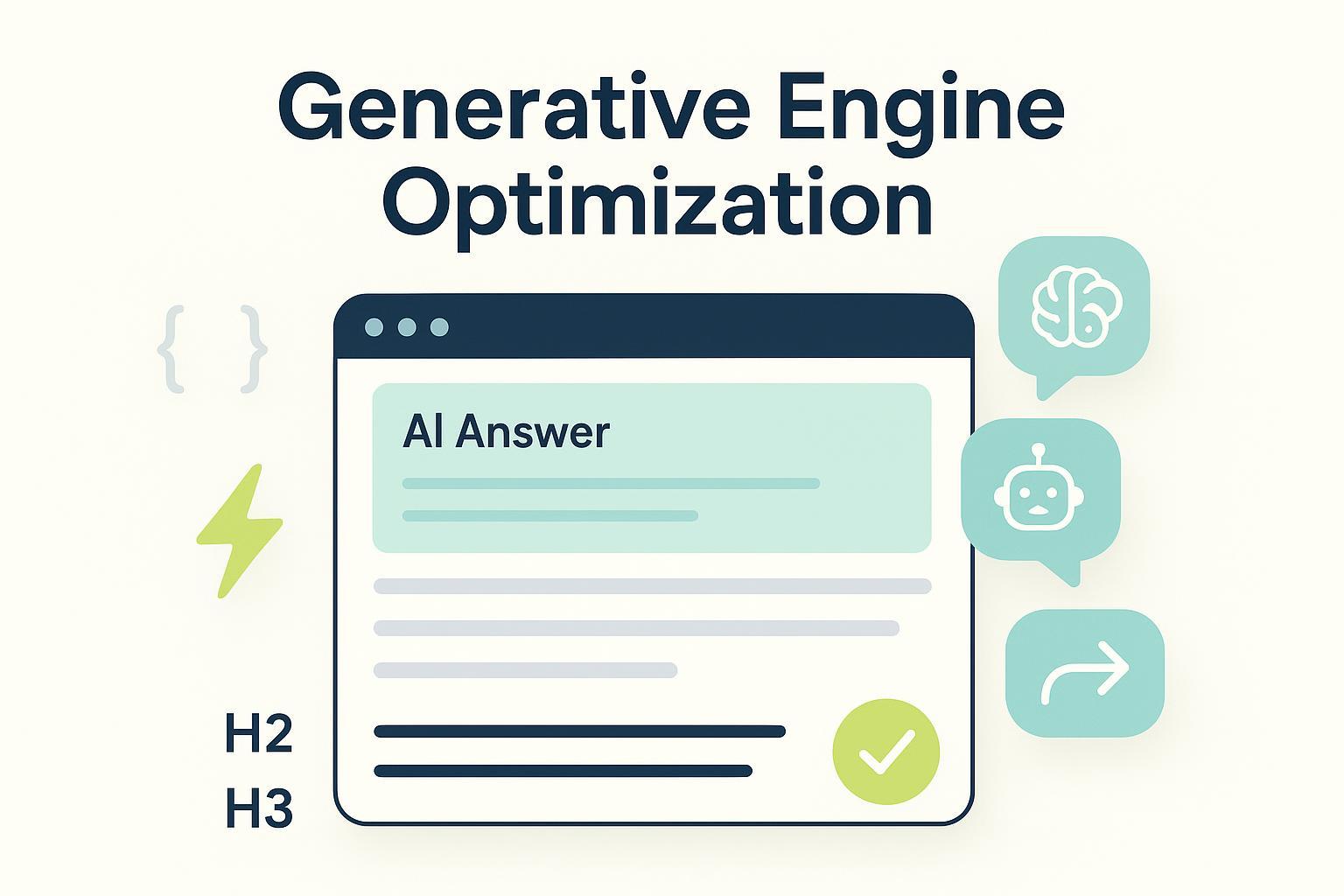How to Master AI Search Optimization in 2025
Master AI search optimization in 2025 by leveraging AI tools, understanding user intent, and optimizing content for AI-driven search engines.


AI changed digital marketing in 2025, making search easier for businesses. Now, 86% of SEO experts use AI tools to compete. Old SEO tricks, like adding keywords and fixing metadata, aren’t enough. AI Search Optimization now focuses on knowing what users want, automating tasks, and creating custom content. Companies using AI saw up to 45% more organic traffic, showing its big impact. To succeed, you need to change your plans and use AI-powered search tools.
Key Takeaways
AI search optimization means knowing what users want and making content they need. This helps get more clicks and better rankings.
AI tools make finding keywords easier. These tools show useful words and trends to help create good content.
Voice search is becoming more common, so it's important to prepare. Write content that answers questions simply and clearly for voice searches.
Use structured data to make your site show up better in searches. It helps AI understand your site and can create special search results that get more clicks.
Keep updating your SEO methods to match AI changes. Fast, mobile-friendly sites without mistakes rank higher and work better for users.
Understanding AI Search Optimization
What is AI Search Optimization?
AI search optimization means improving how your website shows up in AI-driven search engines. It’s different from old methods because it matches your content with how AI systems understand and share search results. This includes using clear data, simple language, and different types of content to meet what users want. For example, clear data helps AI understand your site better, making it more likely to show up in special results like snippets or panels. By focusing on AI, your website stays useful in a tough online world.
The Shift from Traditional Search Engine Optimization to AI
Switching from old SEO to AI-driven methods is a big change in how websites get visitors. Old SEO used keywords and links a lot. AI search optimization now focuses on what users want, the meaning behind searches, and smart tools. For example, AI tools study user actions to guess what content they’ll like most. This change has brought better results like more visitors, higher interaction, and more people taking action on websites.
What It Measures | Why It Matters for AI SEO | |
|---|---|---|
Traffic | Counts how many people visit a site | Shows how well SEO attracts users |
Conversion Rates | Tracks how many visitors do what you want | Shows how engaging your content is |
Engagement Rates | Measures how users interact with your site | Shows if your content keeps users interested |
Clickthrough Rates (CTR) | Counts how many people click links | Helps understand how visible your content is |
These numbers show why AI is important for search strategies.
Key Components of AI Search Optimization
To do well in AI search optimization, focus on these key parts:
User Engagement: Check bounce rates and time spent on pages to see if users like your content.
Voice Search Optimization: Make sure your site works well with voice searches, which are growing fast.
Snippet Performance: Getting into featured snippets makes your site easier to find in AI-driven search results.
Content Diversity: Use different formats like videos, charts, and FAQs to match what users prefer.
By working on these areas, you can build a strong plan that fits with AI and its new abilities.
Actionable Strategies for AI Search Optimization

Using AI Tools for Keyword Research and Content Creation
AI tools have made keyword research and content creation simpler. They study large amounts of data to find trends and chances that older methods might miss. Start by using AI to group keywords based on how often they’re searched and how tough the competition is. This helps you pick words that are useful and easier to rank for. For example, long-tail keywords, which are detailed and less competitive, can bring specific visitors to your site.
AI tools are also great at finding related keywords and guessing what users might search for next. Knowing this lets you create content that answers questions before users even ask. This smart planning not only makes your site more visible but also shows it as a trusted source of information.
For creating content, AI can help make high-quality pieces that fit your audience. These tools check current content, find missing parts, and suggest ways to improve. This keeps your material fresh and interesting. By using AI in keyword research and content creation, you can make your site better for AI-powered searches and stay ahead of others.
Optimizing for User Intent and Context
Knowing what users want is key to making good content. AI strategies match your content with user intent types: informational, navigational, commercial, and transactional. For example, if users want information, your content should give clear answers. If they want to buy something, strong calls-to-action (CTAs) can guide them to act.
Organizing your content to fit user intent boosts engagement and meets AI search engine needs. Use clear titles, bullet points, and helpful tips to make your content easy to follow. AI tools can study user actions and help you adjust your content to match their needs. For instance, making your content easy to read helps both users and AI systems understand it better.
A real-life example shows why this works. Businesses that focus on user-first strategies see more engagement and sales. Matching search intent with quick answers and helpful solutions pleases users and signals search engines that your content is valuable. This makes optimizing for user intent a must for AI search success.
Structuring Content for AI Features like Rich Snippets
Rich snippets make your site stand out in AI search results. These features add extra details about your content, making it more attractive. For example, a recipe snippet with star ratings and cooking time can boost clicks. Organized content is key to getting these results.
To get rich snippets, use structured data. This means arranging your content so AI systems can easily read it. Adding schema markup to your pages helps search engines show features like review stars, prices, and FAQs. This not only improves visibility but also increases user interest.
Studies show that sites with rich snippets see an 82% rise in clicks compared to those without. This tells search engines your content is useful, improving your rankings. Structured content also helps with voice and visual searches, as it’s easier for AI tools to understand. By focusing on structured content, you can succeed in AI-driven strategies and stay ahead of competitors.
Technical Search Engine Optimization for AI Crawlers
To do well in AI-driven search, make your site ready for AI crawlers. These crawlers check your site differently than older search engines. They look at context, structure, and how useful your content is. Fixing your technical SEO helps AI systems understand your site better and rank it higher.
1. Use Structured Data for Better AI Understanding
Structured data helps AI crawlers read your content clearly. Adding schema markup gives details about your pages. For example, you can show product info, reviews, or FAQs. This helps AI display your content in rich snippets or special features. Sites with structured data often get more clicks because they stand out.
2. Optimize Website Speed and Performance
Fast websites are important for AI crawlers. Slow pages annoy users and lower engagement. To speed up your site, shrink images, use browser caching, and try a content delivery network (CDN). A faster site ranks better and keeps visitors longer.
3. Ensure Mobile-Friendliness
Most people search on phones now. AI systems like sites that work well on mobile. Use responsive design so your site fits all screen sizes. Test it on different devices to make sure it works smoothly. A mobile-friendly site makes users happy and improves rankings.
4. Add Relevant Citations and Data
AI crawlers trust content with good sources. Adding citations, quotes, and stats makes your content stronger. For example, using industry studies or numbers can boost your site's trust. The table below shows how these methods help:
Method | What It Does | How Much It Helps |
|---|---|---|
Cite Sources | Adds trusted sources to support your claims. | |
Quotation Addition | Uses quotes from experts to make content more reliable. | 30-40% |
Statistics Addition | Includes numbers to give proof and make content stronger. | 30-40% |
Using these tips makes your content better for users and AI systems.
5. Monitor and Fix Technical Errors
Broken links or missing metadata confuse AI crawlers. Check your site often to find and fix these problems. Use tools to spot crawl errors and update your sitemap. A clean site with no mistakes ranks higher in AI-powered search.
6. Leverage AI Tools for Technical SEO
AI tools make technical SEO easier. They check your site, find problems, and suggest fixes. For example, they can help with better internal links or show pages needing updates. Using AI tools keeps you ahead of others and ready for search changes.
Pro Tip: Keep updating your technical SEO to match new AI trends. Search engines change fast, so staying updated helps your site stay strong.
By following these technical SEO tips, you can make your site better for AI crawlers and improve your search rankings.
Future Trends in AI Search Optimization

Voice Search and Conversational AI
Voice search is growing fast in how people use search engines. AI improvements help voice assistants answer hard questions better. They now use your data to give results based on your habits. For example, if you often look for healthy meals, your assistant might suggest low-calorie recipes.
Voice shopping is also becoming popular. Many people now shop online using voice commands. To keep up, you should make your content work for voice searches. With 5G, voice devices will work faster and smoother. Better Natural Language Processing (NLP) helps assistants understand accents and phrases, making them useful for more people.
Generative AI and Predictive Analytics
Generative AI is changing how search engines work. These tools create content, predict trends, and adjust to user needs. For instance, websites may need frequent updates to match AI changes. Search engines now value real and honest content, so focus on being clear and trustworthy.
Evidence Type | What It Does |
|---|---|
Generative Engine Optimization | Tracks AI content success and adds AI data to SEO plans. |
Multimodal Optimization | Includes images and videos, so all media types need updates. |
Predictive Analytics in SEO | AI predicts trends and finds chances to improve decisions. |
Using predictive analytics helps you guess what users will search for. You can then make content that answers their needs early.
Personalization and Hyper-Targeting in AI Search
AI search shows that personalization is key to keeping users interested. AI systems study your browsing, buying, and likes to give custom experiences. For example, stores use AI to suggest items based on what you’ve seen or bought before. This makes customers happier and more loyal.
Example Sector | How It Helps |
|---|---|
Retail | |
Financial Services | Banks use data to give advice based on your spending. |
Marketing Strategies | Personal messages sent through favorite channels boost conversions. |
Hyper-targeting makes sure your content reaches the right people at the right time. This improves user interest and increases sales, making it a key part of AI search plans.
The Role of GEO (Generative Engine Optimization) in 2025
Generative Engine Optimization (GEO) is key for search success in 2025. It helps improve content for AI systems that use generative models. Unlike old SEO, GEO focuses on how AI reads and creates answers.
AI now values fresh and high-quality data. Updating your content often keeps it useful and easy to find. Personalization is more advanced than ever. AI adjusts results based on user actions, so content must fit different types of people. Formats like voice and visuals are also important. GEO must include these to handle more non-text searches.
Gartner says conversational AI will cut search engine use by 25% by 2026. This shows why GEO is vital as fewer people use traditional search.
Trust is a big deal in GEO. AI prefers brands with honest practices and good sources. Adding citations and following new rules can make your content more reliable. As AI grows, rules for GEO may become like those for older search engines.
To do well with GEO, focus on these steps:
Keep content fresh to match AI's need for new info.
Personalize content for different users and their needs.
Use formats like voice and visuals to reach more people.
Build trust with accurate and well-sourced content.
Learn about new GEO rules and follow them.
By using GEO, your content can stay strong in AI-powered searches.
AI-Powered Tools for Search Optimization
Geneo: A Smart Tool for AI Search Success
Geneo is a helpful tool for improving your website's search results. It uses AI to make your site easier to find and perform better online. With features like smart analytics and content tips, Geneo makes AI search optimization simple.
Geneo's strength is in checking and boosting your site's performance. It focuses on things like understanding searches, remembering context, and spotting trends. These features help your content match what AI and users need. The table below shows how much each feature matters in Geneo's process:
Feature | Importance |
|---|---|
Search Understanding | 5 |
Web Search | 10 |
Info Summarizing | 8 |
Adding Sources | 4 |
Context Memory | 5 |
Combining Sources | 6 |
Trend Spotting | 5 |
User Behavior Study | 7 |
Geneo also helps create new, useful, and trusted content. It checks your current material and suggests updates to fit AI search needs. This keeps your site competitive and easy to find. Its simple design works for both small and big businesses.

Using Geneo can help your site stay ahead in AI search and attract more visitors.
Tools for Understanding Search Intent and User Actions
Knowing what people want when they search is very important. AI tools make this easier by studying lots of data and giving useful tips. These tools help you create content that matches what users are looking for.
Keyword tools like Semrush group keywords by purpose—learning, buying, or deciding. This helps you make content that fits user searches. For example, if users want product reviews, you can write detailed comparison articles.
Language tools help by figuring out the meaning behind searches. They find patterns in what people look for, helping you plan for future trends. Tools like Bombora track what people read to guess what they might buy.
Analytics tools like Google Analytics check if your guesses about user intent are right. They show data like bounce rates and time spent on pages. This helps you adjust your content to keep users interested.
By using these tools, you can learn more about your audience and create content they enjoy.
Platforms for Tracking and Boosting AI Search Performance
To do well in AI search, you need special platforms. These platforms fix problems like slow loading and delays, keeping your site competitive.
The table below lists common problems, fixes, and how much they help:
Problem | Fix | Improvement |
|---|---|---|
Slow data loading | Use caching | |
Slow AI processing | Use GPUs | 2-5x faster |
Network delays | Add CDNs | 20-40% faster |
Limited resources | Upgrade storage | Up to 10x faster |
"It's not just about one part being fast, but the whole response being quick." - Dr. Sharon Zhou, CEO of Lamini
These platforms also offer tools for better hardware and caching. These upgrades can make AI systems much faster, improving your site's speed and user experience. Using GPUs speeds up AI tasks, so your content loads quickly.
By using these platforms, you can improve your site's performance and stay ahead in AI search.
Keeping up with AI-powered search engines is crucial to succeed online. AI helps you understand your audience better and improves marketing results. It also makes your content more engaging. The table below shows how AI search optimization changes digital marketing:
Area of Impact | What It Does |
|---|---|
Better Content Marketing | Personalization boosts engagement and increases conversions. |
Staying Ahead of Rivals | AI users perform better in key metrics than competitors. |
Higher Marketing ROI | AI raises ROI by about 20% (McKinsey, 2022). |
Deeper Audience Insights | AI builds detailed profiles beyond just age or location. |
Smarter Content Planning | AI predicts which content will work before you invest. |
Tools like Geneo make this easier by giving helpful tips and AI-based ideas. Using AI tools and keeping up with trends will help your site stay visible and important in the changing online world.
FAQ
How is AI search optimization different from traditional SEO?
Old SEO uses keywords and links to rank sites. AI search optimization uses smart tools to study searches and user actions. AI systems look at context and give custom results. To rank higher, make your content fit these advanced tools.
How do you make content better for AI search engines?
Focus on what users want and use clear data. Add schema markup to help AI understand your site. Use videos, charts, and FAQs to make content interesting. Update your site often to stay useful. Good backlinks also build trust and improve rankings.
Why does search intent matter for AI search engines?
Search intent helps AI match questions with the right answers. Knowing what users need makes your content more helpful. This boosts trust and keeps users interested. For example, if users want to shop, your content should guide them to buy.
How does trust improve AI search optimization?
AI likes content that feels reliable. Adding sources, facts, and expert quotes builds trust. This helps your site rank better and keeps users engaged. Trust also makes your site stand out in tough searches.
What does artificial intelligence do in search optimization?
AI runs smart search engines. It studies user actions, guesses trends, and gives custom results. AI tools help you write content that fits searches. They also fix site problems to make sure your site works well.
See Also
Understanding AI Search: Functionality And Its Mechanisms
Strategies For Achieving High Rankings In AI Overviews
Conducting A Brand Audit Within AI Overviews Effectively
Effective Techniques To Improve Your Rank In Perplexity AI
Steps To Successfully Implement Generative Engine Optimization





